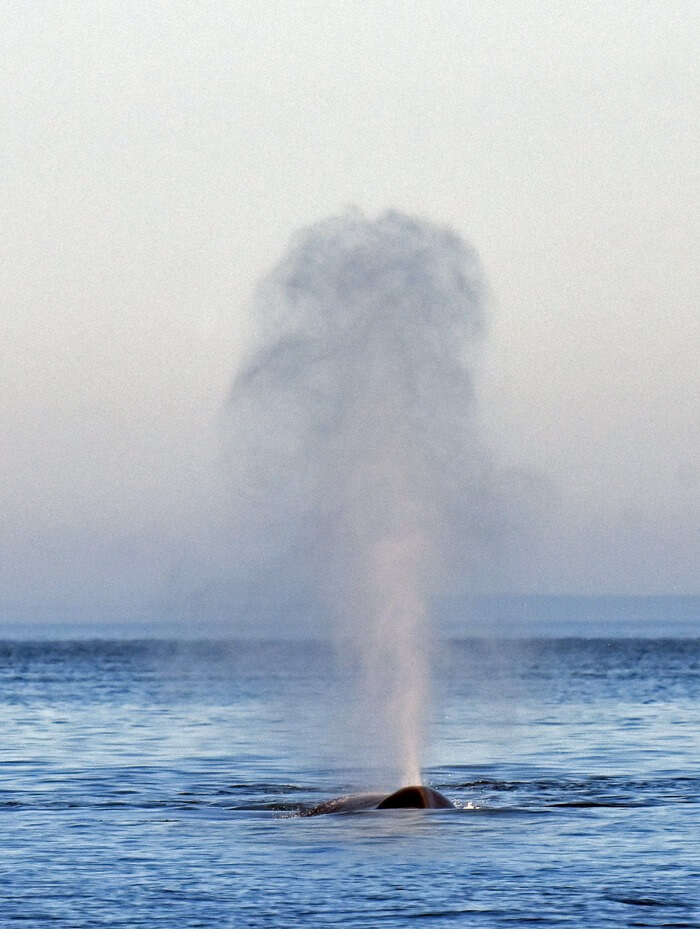On August 4, a speckled back contrasts with the white backs of belugas swimming below the Pointe-Noire land observation platform in Baie-Sainte-Catherine. Laurence Tremblay, a research assistant of the Group for Research and Education on Marine Mammals (GREMM), aims her camera lens at the group. Thanks to her focus, she manages to snap the narwhal’s picture!
Belugas and narwhal are stirring near the surface. Their bodies brush against each other, almost jostling one another. The narwhal’s twisted left canine rises into the air. In an adult narwhal, this tooth can reach a very respectable 2.5 metres long! But the narwhal that has been swimming in the St. Lawrence since 2016 does not yet boast such a large tusk.
Belugas pound the narwhal using a behaviour known as “pelvic thrusting”. Is this their way of practising for breeding? A sort of “handshake” amongst members of the same clan? A movement that is simply pleasant to perform? This is the kind of not-so-straightforward question that interests GREMM’s research team.
On August 5, the narwhal was seen in Baie-Sainte-Marguerite, Sacré-Coeur.
Blue whales near the coast
In recent days, blue whales have been venturing close to shore in Les Escoumins. “It’s rare that I am able to see them so close,” says a surprised worker from the Canadian Coast Guard’s Marine Communications and Traffic Services, who watches the largest animals on the planet from his office window on August 2. That same day, he spots a group of about fifty belugas.
Like narwhals, blue whales can be recognized by the spotty patchwork that covers their backs. Researchers and enthusiasts therefore scour photos of individuals and try to make out shapes in the patterns of spots in order to facilitate comparisons.
Other blue whales are spotted off the coasts of Matane and Sept-Îles. Unfortunately, blue whales are endangered. Canada’s Marine Mammal Regulationsrequire that vessels maintain a minimum distance of 400 metres from blue whales in the St. Lawrence Estuary.
This distance was not chosen at random. A study published in the scientific journal Endangered Species Research reveals that when a vessel is present in proximity (particularly at distances of less than 400 m, though even upwards of 1,000 m), blue whales spend less time at the surface, take fewer breaths and make fewer deep dives, all of which translates into less efficient foraging. And when you have a 28-metre-long body to feed, it’s best to devour as much krill as possible!
Eat, eat, eat
The St. Lawrence serves as a smörgåsbord for whales and seals that migrate to its waters for the summer. Imagine how good the feeding must be if marine mammals are willing to take a detour down a cul-de-sac a few hundred kilometres long!
Just outside Tadoussac’s Marine Mammal Interpretation Centre, a surface feeding minke whale surprises visitors almost on a daily basis as they leave the exhibit hall.
In the Saguenay-St. Lawrence Marine Park, a couple handfuls of humpbacks cash in on the zooplankton and schools of small fish in the area. Fin whales also abound by the dozens. Additionally, harbour porpoises seem to be particularly plentiful this year.
This past week, our collaborator Renaud Pintiaux witnessed an amusing scene involving a grey seal. The animal was devouring its prey, likely a redfish. Tempted by the catch, a gull begins to harass the seal, which in turn disappears below the surface. A few seconds later, the seal nearly leaps out of the water to scare the gull away. Its tactic works! The winged robber hightails it out of there.








